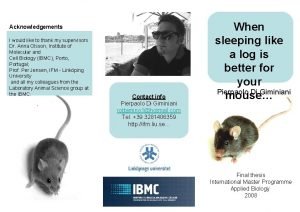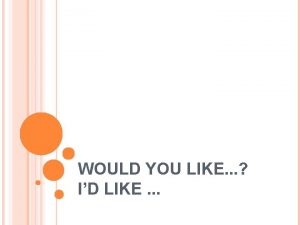Acknowledgements I would like to thank my supervisors


- Slides: 2

Acknowledgements I would like to thank my supervisors Dr. Anna Olsson, Institute of Molecular and Cell Biology (IBMC), Porto, Portugal; Prof. Per Jensen, IFM - Linköping University and all my colleagues from the Laboratory Animal Science group at the IBMC. Contact info Pierpaolo Di Giminiani rottamino 1@hotmail. com Tel. +39 3281406359 http: //ifm. liu. se. . . When sleeping like a log is better for your Pierpaolo Di Giminiani mouse… Final thesis International Master Programme Applied Biology 2008

Aim To investigate the effect of three different levels of isoflurane anaesthesia on the ability of mice to form memory. Background Anaesthesia has always been considered a totally reversible process having no secondary effects on the cognitive capacity of the patients. However, several clinical studies reported individuals experiencing difficulties with concentration and memory for days or weeks after surgery. Isoflurane is one of the most extensively used inhalation anaesthetic in veterinary practice, especially for its quick recovery time and for its rapid clearance from the body. Previous studies have shown that isoflurane affected the ability of rodents to retain memory for periods of time longer than the expected. Mouse undergoing anaesthesia Results No signs of anxiety or abnormal behaviour were observed the day after anaesthesia in any of the groups. The animals anesthetized with 1% isoflurane required to travel longer distances and for more time before Morris water maze solving the water maze (reaching the Method escape platform above water level). The groups anesthetized with higher 32 C 57 BL/6 J mice were divided into 4 concentrations of the anaesthetic were groups: 3 assigned to 3 different not affected. concentrations of isoflurane (1%, 1. 5% and 2%) and 1 non-anesthetized group (control). One day after anaesthesia they Conclusions were tested in an open-field test in order • The anaesthetic agent to assess anxiety/stress or any abnormal behaviour. Subsequently, they were isoflurane did not have any tested in a Morris water maze, for direct effect on the anxiety assessing their ability to acquire spatial level of the animals 24 hours memory (by measuring time and after the anaesthesia. distance required by the animals to solve the maze). • Isoflurane caused cognitive impairment in animals anesthetized with the lowest concentration (1%), in fact, making it more difficult for them to form memory. Average distance travelled by the treatment groups (1%, 1. 5% and 2%) and the controls.



